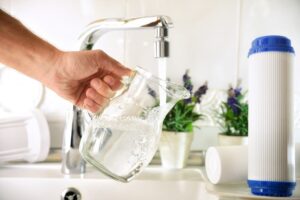Cruising is about more than just loving life on the water. It’s important to learn the mechanics of how your boat actually works, what products you need, and when parts need to be replaced. It’s time to learn about piston pumps and plunger pumps! For the most part, these two types of pumps function the same way. That being said, there are a few main differences. Let’s go into this more right now.
What is a Piston Pump?
By simple definition, a piston pump is a type of positive displacement pump where the high-pressure seal reciprocates with the piston. A piston is a component of reciprocating engines, reciprocating pumps, gas compressors and pneumatic cylinders, and mechanisms of the like. It is the moving component that is contained by a cylinder and is made tight by piston rings. In a boat engine, its purpose is to transfer force from expanding gas in the cylinder to the crankshaft via a piston or connecting rod.
For the purposes of your boat, the piston pump consists of a cylinder with a reciprocating piston connected to a rod which passes through a gland at the end of the cylinder. The water enters from the suction line through a suction valve and is discharged through a delivery valve. Piston pumps may be double acting, unlike a plunger pump which we will get to more in a moment.
You can also find pistons in a pump. In this case, the function is reversed and force is transferred from the crankshaft to the piston for the purpose of compressing or ejecting the fluid in the cylinder. In limited boats, the piston also acts as a valve by covering and uncovering ports in the cylinder wall.
How Does A Piston Pump Work?
In a piston pump, the piston moves back and forth inside a cylinder. On the suction stroke, the piston retracts, creating a vacuum that draws fluid into the cylinder through an inlet valve. On the discharge stroke, the piston pushes the fluid out through an outlet valve.
The sealing system in a piston pump is located on the piston itself, which moves within the cylinder. Because of this design, piston pumps are slightly more limited in pressure capability compared to plunger pumps, but are excellent for handling viscous or slurry-like fluids.
What is a Plunger Pump?
A piston is similar, but not the same, as a plunger pump. A plunger pump is a type of positive displacement pump where the high-pressure seal is stationary, and a smooth cylindrical plunger slides through the seal. These use a reciprocating plunger to pressurize water and force it through the outlet valve. This may seem like a small difference, but it makes them different from piston pumps. This feature allows them to be used at higher pressures.
Mainly, plunger pumps differ from piston pumps because they have one or constant diameter plungers reciprocating through packing glands and displacing liquid from cylinders in which there is considerable radial clearance. Plunger pumps are single acting, meaning only one end of the plunger is used in pumping the liquid.
If you have any additional questions, we’re always here to answer them! This means whether you want to learn more about water makers, how a desalination system works, turning saltwater to freshwater, or more about your piston and plunger pumps, we’re the team to contact. We’re always here for you, because we’re cruisers too!
How A Plunger Pump Works
A plunger pump functions similarly to a piston pump in terms of the basic principle of drawing in and pushing out fluid. However, the key difference lies in where the seal is located. In plunger pumps, the seal is stationary, and the plunger slides through it.
As the plunger retracts, it creates a vacuum that allows fluid to enter the chamber through an inlet valve. When the plunger moves forward, it forces the fluid out through the outlet valve. Because the seal does not move, it experiences less wear and can withstand higher pressures for longer periods.
Difference Between Them
While both pump types share a similar mechanism, their structural differences result in different performance characteristics and applications.
- Seal Location: In piston pumps, the seal moves with the piston inside the cylinder. In plunger pumps, the seal is fixed, and the plunger moves through it.
- Pressure Capability: Plunger pumps are typically more capable of handling higher pressures because the stationary seal allows for better pressure retention and less wear.
- Maintenance: Piston pumps may require more frequent maintenance due to the moving seal, while plunger pumps generally have longer service intervals.
- Fluid Type: Piston pumps handle viscous or particulate-laden fluids better. Plunger pumps are better for clean fluids under high pressure.
- Durability: Plunger pumps are often more durable in high-pressure applications, whereas piston pumps offer better performance in handling abrasive materials.
Ready to Upgrade Your Onboard Experience?
Whether you’re cruising full-time or just preparing for your next adventure, Cruise RO Water and Power has the reliable watermakers and power solutions you need. Browse our products or contact our team today to find the right system for your vessel.



